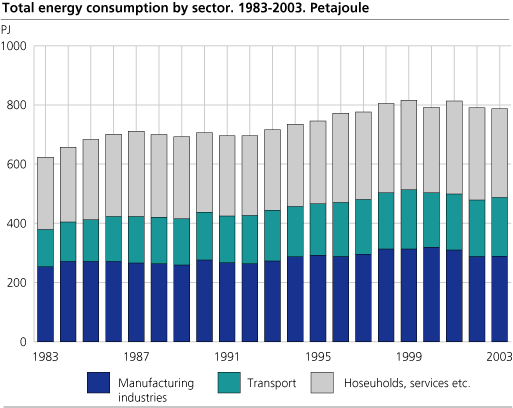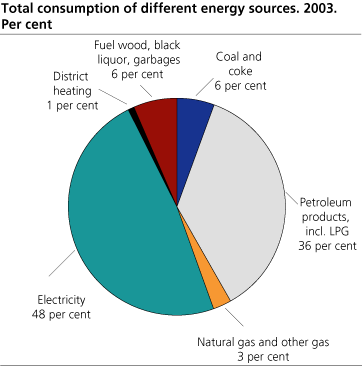Content
Published:
This is an archived release.
Electricity replaced by oil
Preliminary figures show a small drop in energy consumption in Norway last year, by 0.4 per cent from 2002. The decrease may partially be attributed to record high power prices in 2003, and higher temperature than in the previous year. The high electricity prices in 2003 contributed to a change in the composition of different energy sources. Electricity consumption declined considerably, while the use of oil products increased.
About half of the total energy consumption in Norway is electricity. The reduction in total energy consumption is due to a huge drop in the use of electricity. In 2003, the electricity consumption was 103.4 per cent, which is 4.5 per cent lower than in 2002. The electricity consumption has not been lower since 1996. Total energy consumption was relatively low in both 2002 and 2003 compared with previous years. This is partially due to higher temperature than normal both this years. According to the Norwegian Meteorological Institute, 2003 was the sixth warmest year since the institute started to measure the temperature in 1887. The temperature was 1.3 degrees above the normal in 2003 and 1.1 degree above this normal in 2002.
In 2003, the energy consumption was mostly reduced within households and services etc. by 3.5 per cent from 2002. The consumption of electricity, which is the most important energy source in this sector, was reduced by more than 6 per cent. The drop in electricity consumption was partially compensated by oil consumption that rose by 6 per cent from 2002. In addition, the high power prices during the winter 2002/2003 made investments in equipment that reduces energy consumption more profitable. According to the Norwegian heat pump association, the sale of heat pumps was three times higher in 2002 than in 2001, and this development continued in 2003. Several people have probably also carried through other efforts to reduce energy consumption, such as lowering the indoor temperature etc.
Increased consumption of oil and gas
Total consumption of oil products rose by scarcely 5 per cent, while the consumption of gas increased by 12 per cent. Data for consumption of fuel wood and district heating are not available for 2003, and the 2002 figures are therefore used as preliminary figures for 2003. More than 70 per cent of the households have the possibility to fire with fuel wood. It's therefore likely that the high electricity prices contributed to higher consumption of fuel wood in households last year. Fuel wood makes up about 15 per cent of the total energy consumption in households, and 9 per cent of the energy consumption in manufacturing industries. Fuel wood makes up about 6-7 per cent of the total domestic energy consumption.
Energy consumption used for transport purposes rose by 4 per cent from 2002 to 2003. This is, among other things, due to higher consumption of auto diesel in road transport, and increased oil consumption in coastal shipping. Consumption of gasoline fell by about 1 per cent from 2002 to 2003.
In manufacturing industries, the total energy consumption in 2003 remained almost unchanged from 2002. The energy consumption rose in manufacture of paper and paper products and in manufacture of energy intensive industries. This might be due to production growth in these sectors. For other manufacturing industries, the energy consumption dropped slightly last year, something that might be attributed to lower production in most other manufacturing industries. According to the preliminary figures, it seems that the manufacturing industries replaced electricity with other energy sources in some degree. The consumption of oil products and gas rose by 5 and 11.5 per cent respectively, while consumption of electricity declined slightly. Consumption of coke rose by 2 per cent, while coal consumption fell by 4 per cent.
Higher energy prices
Preliminary figures show that the electricity price for households in 2003 was record high, with 90 øre/kWh in average, incl. taxes. The price was very high through the first quarter in 2003, with 114.98 øre/kWh. In comparison, the electricity price for households was approximately 60 øre/kWh on average in 2001 and 2002 and has been around 50 øre/kWh on average in the previous 5 years. The prices on light heating oil and heating kerosene rose last year, but oil products were still cheaper than electricity. The list price on heating kerosene and light heating oil was 80.5 and 67.7 øre/kWh respectively, converted to utilize energy. It is usually discounts on the oil prices, and oil products were by that an obvious profitable alternative.
Higher production of natural gas and wind power
The production of natural gas was higher than ever in 2003, with 77.6 billion Sm3. The gas production rose by 11 per cent from 2002, while the production of crude oil decreased by 4.6 per cent. Production of electricity was 107.3 TWh. This is 18 per cent less than in 2002, and the lowest level since the dry year 1996. The low production may be attributed to little rainfall in the autumn 2002, and small snowfall during the winter 2002/2003. This lead to lower snow melting than normal in the spring 2003. The production of wind power rose considerably in 2003, and came to 222 GWh, which is almost six times more than in 2002. Two large new windmill parks on Smøla in Møre og Romsdal county, and Havøygavelen in Finnmark county produced a large share of this. About 0.2 per cent of the total electricity production in Norway was wind power in 2003.
Tables:
The statistics is now published as Production and consumption of energy, energy balance and energy account.
Additional information
The statistics are published in spring and autumn. The spring publication is preliminary and aggregated to a larger degree, and only includes figures for energy balance. In the autumn publication, tables are also presented for the energy accounts.
Contact
-
Statistics Norway's Information Centre
E-mail: informasjon@ssb.no
tel.: (+47) 21 09 46 42


